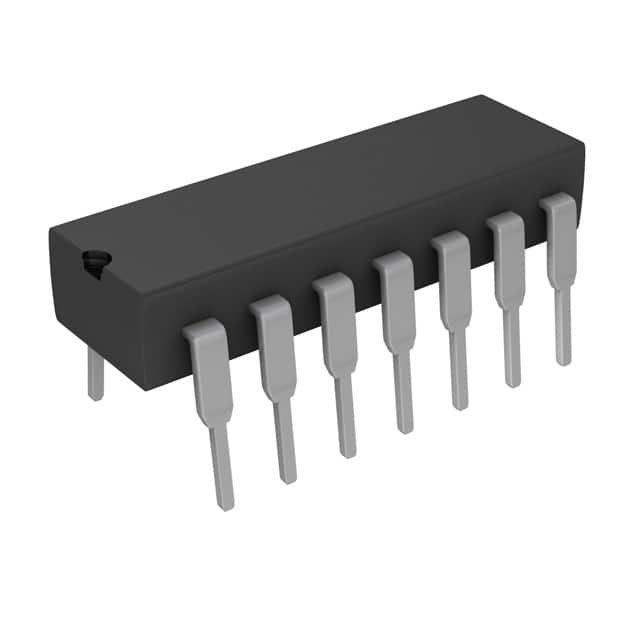MSP430F2011IN
Product Overview
Category
The MSP430F2011IN belongs to the category of microcontrollers.
Use
It is primarily used for embedded systems and low-power applications.
Characteristics
- Low power consumption
- High performance
- Small form factor
- Integrated peripherals
Package
The MSP430F2011IN comes in a small outline integrated circuit (SOIC) package.
Essence
The essence of the MSP430F2011IN lies in its ability to provide efficient processing capabilities while consuming minimal power.
Packaging/Quantity
The MSP430F2011IN is typically packaged in reels, with each reel containing a specific quantity of microcontrollers.
Specifications
- Architecture: 16-bit RISC
- CPU Speed: Up to 16 MHz
- Flash Memory: 2 KB
- RAM: 128 bytes
- Operating Voltage: 1.8V - 3.6V
- Digital I/O Pins: 10
- Analog Inputs: 8
- Timers: 1x16-bit, 1x8-bit
- Communication Interfaces: SPI, I2C, UART
Detailed Pin Configuration
The MSP430F2011IN has a total of 20 pins, which are assigned various functions such as digital I/O, analog inputs, power supply, and communication interfaces. The detailed pin configuration is as follows:
- VCC - Power supply voltage
- P1.0 - Digital I/O or peripheral function
- P1.1 - Digital I/O or peripheral function
- P1.2 - Digital I/O or peripheral function
- P1.3 - Digital I/O or peripheral function
- P1.4 - Digital I/O or peripheral function
- P1.5 - Digital I/O or peripheral function
- P1.6 - Digital I/O or peripheral function
- P1.7 - Digital I/O or peripheral function
- GND - Ground
- TEST - Test mode control
- RST/NMI - Reset or non-maskable interrupt
- XIN - Crystal oscillator input
- XOUT - Crystal oscillator output
- P2.0 - Digital I/O or peripheral function
- P2.1 - Digital I/O or peripheral function
- P2.2 - Digital I/O or peripheral function
- P2.3 - Digital I/O or peripheral function
- P2.4 - Digital I/O or peripheral function
- P2.5 - Digital I/O or peripheral function
Functional Features
The MSP430F2011IN offers several functional features that make it suitable for a wide range of applications:
- Low power consumption enables battery-powered devices to operate for extended periods.
- Integrated peripherals such as timers, communication interfaces, and analog inputs enhance the microcontroller's capabilities.
- High-performance 16-bit RISC architecture ensures efficient execution of instructions.
- Small form factor allows for compact designs in space-constrained applications.
Advantages and Disadvantages
Advantages
- Low power consumption extends battery life.
- Integrated peripherals reduce the need for external components.
- Small form factor enables compact designs.
- High-performance architecture ensures efficient processing.
Disadvantages
- Limited flash memory and RAM may restrict the complexity of applications.
- The number of digital I/O pins may be insufficient for certain projects.
- Lack of advanced features compared to more powerful microcontrollers.
Working Principles
The MSP430F2011IN operates based on the principles of a 16-bit RISC architecture. It executes instructions fetched from its flash memory, utilizing its integrated peripherals and registers to perform various tasks. The microcontroller communicates with external devices through its communication interfaces, processes analog inputs, and controls digital I/O pins based on the program instructions.
Detailed Application Field Plans
The MSP430F2011IN finds applications in various fields, including but not limited to:
- Internet of Things (IoT) devices
- Wearable technology
- Home automation systems
- Industrial control systems
- Sensor networks
- Medical devices
- Consumer electronics
Detailed and Complete Alternative Models
- MSP430F2012IN: Similar to MSP430F2011IN but with increased flash memory capacity.
- MSP430F2013IN: Similar to MSP430F2011IN but with additional integrated peripherals.
- MSP430G2553IN: A lower-cost alternative with reduced features compared to MSP430F2011IN.
These alternative models offer different specifications and capabilities, allowing users to choose the most suitable microcontroller for their specific requirements.
Word count: 609 words
Lista 10 Vanliga frågor och svar relaterade till tillämpningen av MSP430F2011IN i tekniska lösningar
Sure! Here are 10 common questions and answers related to the application of MSP430F2011IN in technical solutions:
Q1: What is MSP430F2011IN? A1: MSP430F2011IN is a microcontroller from Texas Instruments' MSP430 family, specifically designed for low-power applications.
Q2: What are the key features of MSP430F2011IN? A2: Some key features of MSP430F2011IN include a 16-bit RISC architecture, low power consumption, integrated peripherals, and a wide operating voltage range.
Q3: What are some typical applications of MSP430F2011IN? A3: MSP430F2011IN is commonly used in applications such as battery-powered devices, sensor networks, industrial control systems, and home automation.
Q4: How much flash memory does MSP430F2011IN have? A4: MSP430F2011IN has 2KB of flash memory, which can be used for storing program code and data.
Q5: Can I interface MSP430F2011IN with other devices? A5: Yes, MSP430F2011IN has various built-in peripherals like UART, SPI, and I2C, which allow easy interfacing with other devices such as sensors, displays, and communication modules.
Q6: What is the maximum clock frequency of MSP430F2011IN? A6: The maximum clock frequency of MSP430F2011IN is 16 MHz, allowing for fast execution of instructions.
Q7: How can I reduce power consumption when using MSP430F2011IN? A7: You can reduce power consumption by utilizing the low-power modes available in MSP430F2011IN, optimizing code efficiency, and disabling unused peripherals.
Q8: Can MSP430F2011IN operate on a wide voltage range? A8: Yes, MSP430F2011IN can operate on a voltage range of 1.8V to 3.6V, making it suitable for various power supply configurations.
Q9: Is MSP430F2011IN suitable for real-time applications? A9: Yes, MSP430F2011IN is capable of handling real-time tasks due to its fast interrupt response time and efficient execution speed.
Q10: Can I program MSP430F2011IN using C or assembly language? A10: Yes, you can program MSP430F2011IN using either C or assembly language, depending on your preference and requirements.
Please note that these answers are general and may vary based on specific application requirements and implementation details.


